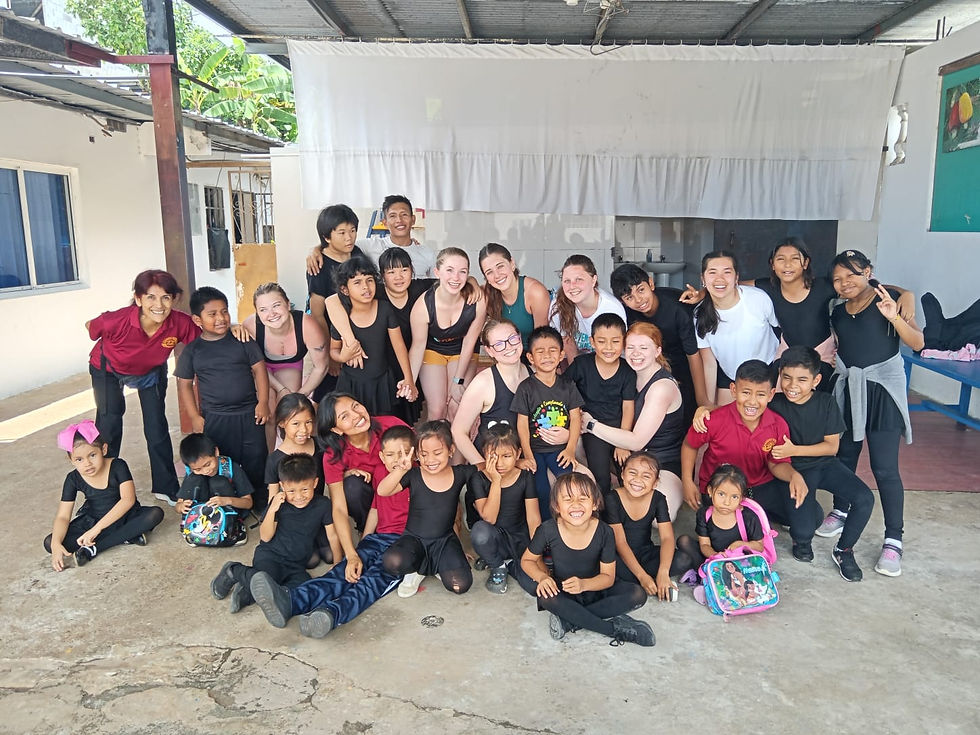Finding Movement, Meaning, and Connection: Dancers Reflect on Their Exchange in Panama
- Info (Movement Exchange)
- Jun 2
- 4 min read
At the beginning of May, a group of dance students from the University of Pittsburgh embarked on a powerful journey through Movement Exchange’s international dance exchange in Panama. What started as a chance to teach and learn quickly evolved into something much deeper—an experience rooted in cultural connection, personal growth, and a reimagining of what dance means in the context of community.
For many of the dancers, teaching free dance classes across various sites like Enlaces, Paninka School, Tribal Gathering, and Barrio Activo was the highlight of the trip. “The most rewarding part of this exchange was teaching all the incredible students!!!” one student shared. Another reflected, “I felt that teaching the children and seeing how happy it made them was the most rewarding part of the experience. When we went to leave the children and they latched on and gave us all hugs, it showed that they crave connections like this and it was great for them to have us there.” Interacting with kids of all ages, skill levels, and backgrounds revealed not only the power of movement but also the universality of joy through dance.
Being immersed in Panama's dance culture left a deep impression on participants, not just technically, but emotionally. One dancer reflected: “This exchange has changed me as a dancer and has taught me the importance of moving our bodies and what a privilege it is to use this form of art to express ourselves.” Another added, “I learned more about my body and the way it can move and how to be more comfortable with it… it also reminded me how much I love to dance and why I do it.” For dancers trained in rigorous academic programs, the freedom and vibrancy of dance rooted in community settings offered a welcome shift in perspective.
As the week unfolded, the concept of dance diplomacy took on new meaning. “It’s more than just learning dance from other cultures,” one student explained. “It’s about learning the history behind the styles and immersing ourselves in the experience. It’s about appreciating the love and skill people bring to forms that may be unfamiliar or challenging to us.” Another shared: “I was shocked at the way that we were able to communicate and interact through dance even with a language barrier. This showed me how important it is to exchange parts of culture through dance and music because it shows how we express ourselves.”
This depth of appreciation opened new doors—not just in their dance training, but in how they view the role of the artist in a global community. “It’s important for artists to exchange with diverse cultures because you can always learn new and different things that broaden your perspective that you can bring back to your own culture,” one participant said. “Dance diplomacy helps us to build relationships with all types of people through a common passion and helps us to understand a little bit more about other cultures.” Another dancer described the experience simply as, “healing through dance. It’s important because dance is a universal language. The more you’re able to experience different cultures and their dance forms, the more you can heal—and the more people you can reach.”
The students also gained practical experience adapting their teaching based on different settings and student needs. “I definitely learned how to change my approach depending on the location,” one dancer noted. “Some places needed a more energetic tone, others allowed us to be more relaxed. I realized that sometimes less is more—especially when working with young kids in a different language.” Another student reflected, “The skills I learned included being able to teach various groups of children the same dance, but having to adapt to different situations. All of the locations provided us with a different challenge and this allowed me to change in the moment and provide the children with the best possible teaching opportunity.”
Learning how to teach with both confidence and flexibility, and watching peers navigate challenges with grace, became just as valuable as the cultural exchange itself. “I learned how to react and improvise based on the situation of each location,” one student explained. “Later in the week, my partner and I saw how other people planned, and then we got together and planned the language we would use to describe the steps so they could understand.” Others reflected on practical growth, like gaining Spanish skills or finding new ways to keep children engaged and energized.
One dancer summarized the emotional impact of the experience: “The most rewarding part was seeing how much the kids enjoyed dancing with us and how happy they were just to have us there. Knowing some of the things they have gone through or their situation at home made me realize how healing dance can be and how grateful I am to be a dancer.”
The exchange concluded with time for reflection, visits to the Panama Canal, a day with the Embera indigenous community, and a trip to Taboga Island; reminders that learning can happen in every moment, not just in the dance studio.
As they head back to Pittsburgh, these students bring with them not just new choreography and teaching tools, but a transformed sense of purpose. They now understand dance as more than performance, it’s a shared language that can build empathy, break barriers, and bring joy to people across cultures.
Move to Change.




.png)



Comments